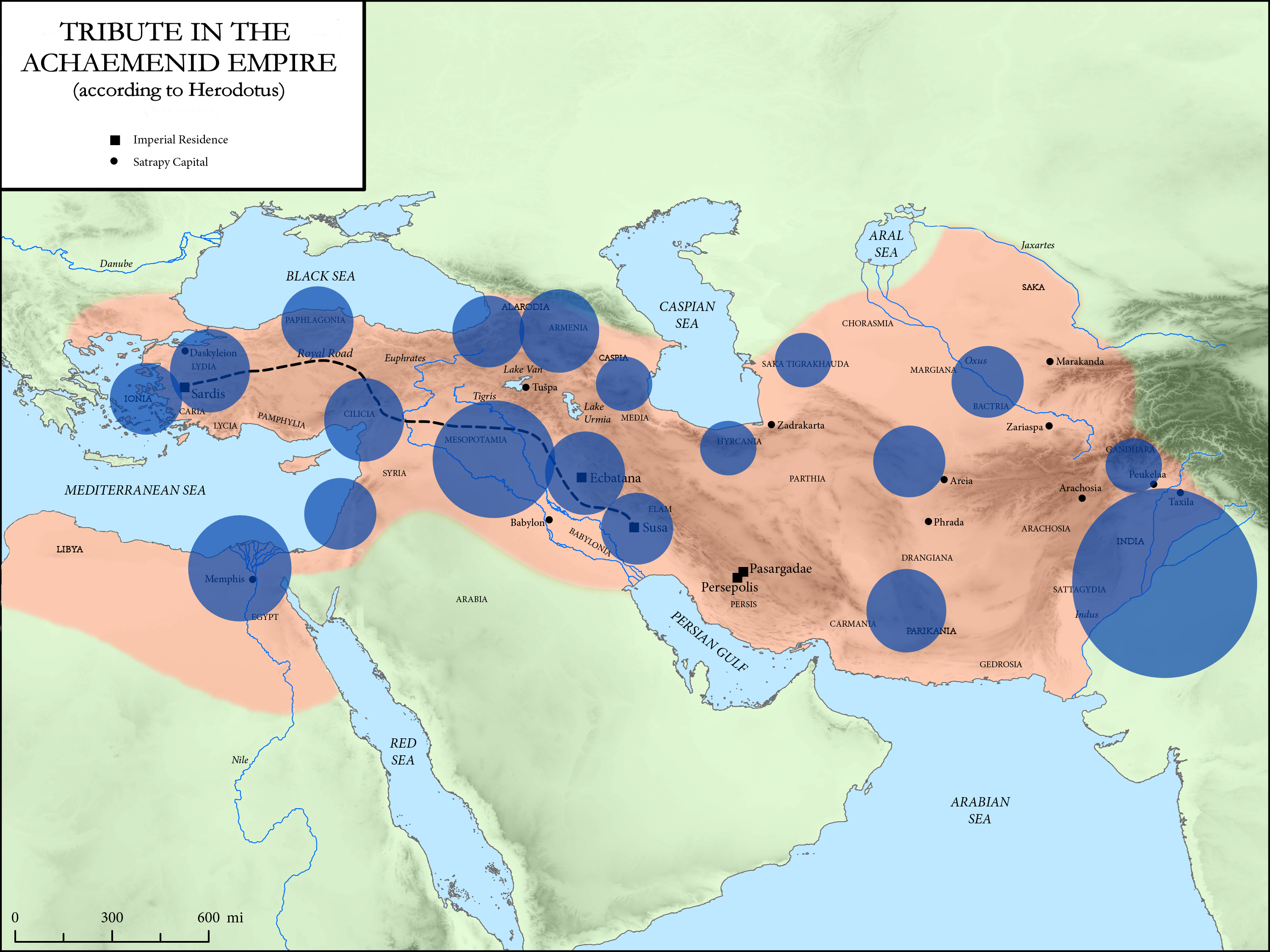|
Districts Of The Achaemenid Empire
Herodotus divided the Achaemenid Empire into 20 districts for the purpose of tribute payments. The following is a description of the ethnic makeup of the districts and the amount they paid in taxes, translated from Herodotus' '' Histories''. Accounting units The quantities of silver are given in Babylonian talent (1 Babylonian talent = about 30.3 kg), while the quantities of gold (India only) are given in Euboïc/Euboean talent (1 Euboïc talent = about 26 kg). Only the Hindush paid in gold, the exchange rate of gold to silver being 1 to 13 by weight at the time of Herodotus. Tax districts The order of the districts given here follows Herodotus, ''Histories'', III.90–94. In hellenocentric way it starts with Ionia and Mysia. The official Persian order of the provinces, as devised under Darius I in 518 BCE, was different and started from the Empire's capital: 1. Media, 2. Susa, etc.Hermann Bengtson, Vladimir Milojčić (ed.), ''Grosser Historischer Weltatlas'', Erster T ... [...More Info...] [...Related Items...] OR: [Wikipedia] [Google] [Baidu] |
Tribute In The Achaemenid Empire
A tribute (; from Latin ''tributum'', "contribution") is wealth, often in kind, that a party gives to another as a sign of submission, allegiance or respect. Various ancient states exacted tribute from the rulers of land which the state conquered or otherwise threatened to conquer. In case of alliances, lesser parties may pay tribute to more powerful parties as a sign of allegiance and often in order to finance projects that would benefit both parties. To be called "tribute" a recognition by the payer of political submission to the payee is normally required; the large sums, essentially protection money, paid by the later Roman and Byzantine Empires to barbarian peoples to prevent them attacking imperial territory, would not usually be termed "tribute" as the Empire accepted no inferior political position. Payments ''by'' a superior political entity to an inferior one, made for various purposes, are described by terms including "subsidy". The ancient Persian Achaemenid Empire ... [...More Info...] [...Related Items...] OR: [Wikipedia] [Google] [Baidu] |
Phoenicia
Phoenicia () was an ancient thalassocratic civilization originating in the Levant region of the eastern Mediterranean, primarily located in modern Lebanon. The territory of the Phoenician city-states extended and shrank throughout their history, and they possessed several enclaves such as Arwad and Tell Sukas (modern Syria). The core region in which the Phoenician culture developed and thrived stretched from Tripoli and Byblos in northern Lebanon to Mount Carmel in modern Israel. At their height, the Phoenician possessions in the Eastern Mediterranean stretched from the Orontes River mouth to Ashkelon. Beyond its homeland, the Phoenician civilization extended to the Mediterranean from Cyprus to the Iberian Peninsula. The Phoenicians were a Semitic-speaking people of somewhat unknown origin who emerged in the Levant around 3000 BC. The term ''Phoenicia'' is an ancient Greek exonym that most likely described one of their most famous exports, a dye also known as Tyrian purpl ... [...More Info...] [...Related Items...] OR: [Wikipedia] [Google] [Baidu] |
Cyprus
Cyprus ; tr, Kıbrıs (), officially the Republic of Cyprus,, , lit: Republic of Cyprus is an island country located south of the Anatolian Peninsula in the eastern Mediterranean Sea. Its continental position is disputed; while it is geographically in Western Asia, its cultural ties and geopolitics are overwhelmingly Southern European. Cyprus is the third-largest and third-most populous island in the Mediterranean. It is located north of Egypt, east of Greece, south of Turkey, and west of Lebanon and Syria. Its capital and largest city is Nicosia. The northeast portion of the island is ''de facto'' governed by the self-declared Turkish Republic of Northern Cyprus, which was established after the 1974 invasion and which is recognised as a country only by Turkey. The earliest known human activity on the island dates to around the 10th millennium BC. Archaeological remains include the well-preserved ruins from the Hellenistic period such as Salamis and Kourion, and Cypr ... [...More Info...] [...Related Items...] OR: [Wikipedia] [Google] [Baidu] |
Yehud Medinata
Yehud, also known as Yehud Medinata or Yehud Medinta (), was an administrative province of the Achaemenid Empire, Achaemenid Persian Empire in the region of Judea that functioned as a Autonomy, self-governing region under its local Jews, Jewish population. The province was a part of the Persian satrapy of Eber-Nari, and continued to exist for two centuries until its incorporation into the Hellenistic period, Hellenistic empires following the conquests of Alexander the Great. The area of Persian Yehud corresponded to the previous Neo-Babylonian Empire, Babylonian Yehud (Babylonian province), province of Yehud, which was formed after the fall of the Kingdom of Judah, the southern Israelites, Israelite kingdom History of ancient Israel and Judah, that had existed in the region prior to the Jewish–Babylonian war, Jewish–Babylonian War and subsequent Babylonian captivity. It had a considerably smaller population than that of the fallen kingdom. Yehud Medinata was the Aramaic, Aramai ... [...More Info...] [...Related Items...] OR: [Wikipedia] [Google] [Baidu] |
Posidium
Ras al-Bassit ( ar, رأس البسيط), the classical Posidium or Posideium ( grc-gre, Ποσιδήιον and Ποσείδιον, ''Posidḗion''), is a small town in Syria named for a nearby cape. It has been occupied since at least the late Bronze Age and was a fortified port under Greek and Roman rule. Herodotus—although not later classical geographers—made it the northwestern point of Syria. Its beaches have a distinctive black sand and are a popular resort destination within Syria. Name "Raʾs" () is the Arabic word for "head", used for headlands and capes. "Bassit" is a transcription of its former name Posidium, as standard Arabic is only able to voice bilabial stops. The Roman name Posidium or Posideium was a latinization of the Greek name Posideion, meaning "laceof Poseidon", the Greek seagod. It was known as "Bosyt" under Ottoman rule. The Syrian municipality is also known as simply Al-Bassit. Geography Ras al-Bassit is a small cape on the Syrian coast of the ... [...More Info...] [...Related Items...] OR: [Wikipedia] [Google] [Baidu] |



